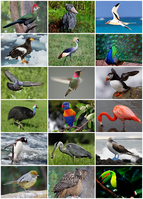
Photo from wikipedia
Bird guano and the faeces of marine mammals appear to be a significant yet undisclosed biotransporter of Endocrine Disrupting Compounds in the marine environment. The authors determined the concentration of… Click to show full abstract
Bird guano and the faeces of marine mammals appear to be a significant yet undisclosed biotransporter of Endocrine Disrupting Compounds in the marine environment. The authors determined the concentration of bisphenol A (BPA), 4-tert-octylphenol (4-t-OP) and 4-nonylphenol (4-NP) removed from birds and seals in their droppings into the coastal zone of the Gulf of Gdansk (Southern Baltic Sea).The research was carried out on samples of bird guano collected during the breeding season and after in 2016 at nesting sites, as well as on faecal samples from grey seals (Halichoerus grypus grypus) living in the Seal Centre of the Marine Station in Hel between 2014 and 2018. Measurements were carried out using high performance chromatography with fluorescence detector. Results have shown that the presence of seabird habitats and grey seal colonies in the coastal zone of the Gulf of Gdansk can have an impact on the pollution of the seashore (beach sand, bottom sediment and surface seawater) with phenol derivatives. The concentrations of BPA, 4-t-OP and 4-NP ranged from 0.1 to 32.97 ng∙g-1dw in sediment and beach sand, and from 0.23 to over 800 ng dm-3 in seawater. In the cases of bisphenol A and 4-tert-octylphenol safe concentration levels in the waters were exceeded. Bisphenol A concentrations were almost always found to be the highest. This was also noted in bird guano and seal faeces, although it was found to be much higher in the seal faeces - average 10149.79 ng g-1 dw, than in bird guano. An experiment conducted to assess BPA, 4-t-OP, 4-NP leaching from bird guano and seal faeces into seawater, also confirmed the importance of animal excrement in the circulation of these compounds in the marine ecosystem. The highest % of leaching related to BPA was noted at 20 °C and reached 84%. The lowest % of leaching was for 4-nonylphenol (44%).
Journal Title: Environmental pollution
Year Published: 2020
Link to full text (if available)
Share on Social Media: Sign Up to like & get
recommendations!